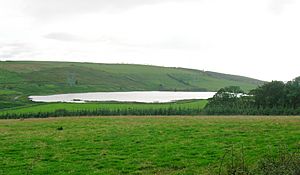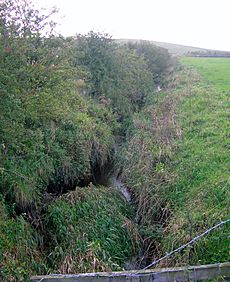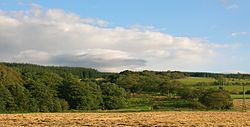Kerse Loch facts for kids
Quick facts for kids Kerse Loch |
|
|---|---|

Kerse Loch from the north-west
|
|
| Lua error in Module:Location_map at line 420: attempt to index field 'wikibase' (a nil value). | |
| Location | Dalrymple, East Ayrshire, Scotland |
| Lake type | Freshwater loch |
| Primary inflows | Rainfall and runoff |
| Primary outflows | Kerse Burn. |
| Basin countries | Scotland |
| Settlements | Dalrymple |
Kerse Loch, also known as Carse Loch, is a small freshwater lake in East Ayrshire, Scotland. It sits in a natural dip in the ground called a 'kettle hole'. This area is part of the Dalrymple Parish.
Contents
About Kerse Loch
What's in a Name?
The name 'Carse' or 'Kerse' comes from the old Scots language. It means "low and fertile land," especially land near a river or water. The name likely described the flat, sometimes wet, land around the loch. Over time, it became known for its rich soil.
Loch Activities and Water Flow
People used to enjoy curling on the frozen loch. Records show curling matches happened there in 1874 and 1846.
The loch mainly gets its water from rainfall and water running off the land. The Kerse Burn flows out of the loch and eventually joins the Water of Coyle. The Kerse Burn has been made deeper and straighter in some parts. By 1978, a boathouse was built on the north side of the loch.
Kerse Castle: A Local Legend
Kerse Loch is near where Kerse Castle once stood. This castle was an old stronghold for the Crawfurd clan. The family later moved to a place called Skeldon House. Old maps show the castle was located to the east of the loch, near the Bow Burn.
The Story of Kerse Castle
Kerse Castle was the home of David Craufurd, the laird (landowner) of Kerse. Today, only a few stones might show where the castle once stood. The castle was first mentioned in records around 1281. It is said to have been destroyed in a big storm in 1797. Reginald, one of the first Craufurds of Kerse, was given the land by his brother Hugh during the time of King Alexander III (1249-1286).
The Legend of 'The Flitting of the Sow'
A famous legend connected to Kerse Castle and the loch is called 'The Flitting of the Sow'. This story is about a long-standing feud between two powerful clans: the Kennedys of Carrick and the Craufurds of Kyle.
The story goes that three days before Lammas (July 29th), Gilbert Kennedy visited Kerse Castle. He told the old Laird of Kerse that his clan would "tether a sow" on the Craufurds' land on Lammas Day (August 1st). This was a huge insult and a challenge!
Both clans gathered their supporters. On Lammas Day, the laird's oldest son, Elspin, led the Craufurds into battle against the Kennedys. The fight happened on the Craufurds' land at the holms of Skeldon. During the battle, John, the laird's other son, was killed. However, the Craufurds eventually won and pushed the Kennedys back. Many Kennedys drowned in the River Doon as they tried to escape.
The old laird was too unwell to fight. He waited anxiously at the castle, looking over Kerse Loch for news. Finally, a rider arrived. The news was sad: his son John had died. But the Craufurds had won, and "the sow had been flitted" (removed).
A descendant of the families, Alexander Boswell, even wrote a poem about this event called Skeldon Haughs; or, the Sow is flitted.
Wildlife at the Loch
In 1846, Kerse Loch was full of fish like pike, perch, and eels. Many types of wild birds also visited the loch, including wild-duck, teal, and widgeon. Today, the loch is part of the Wetland Bird Survey (WEBS), which helps keep track of wetland birds.
Geology of the Area
The area around Kerse Loch has many geological features. There are several large faults (cracks in the Earth's crust) nearby. These include the Kerse Loch Fault and the Littlemill Fault. These faults have created many separate blocks of land in the region.
Local Stories and History
- During the 1926 coal miners' strike, a farmer from Kerspark Farm would cross the frozen loch to buy coal. He bought it from miners who were digging from old coal heaps. One time, his cart broke through the ice and sank!
- Children from the nearby Cairntable miner's village often swam in the loch. The spot where the girls swam was called the 'Coo-Creep'.
- Cairntable Halt was a train station located near the miner's village of Cairntable.



